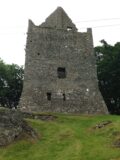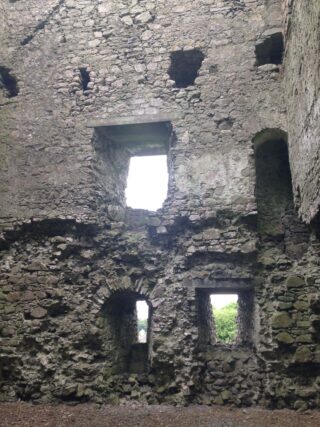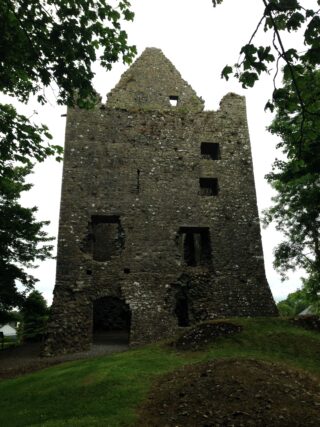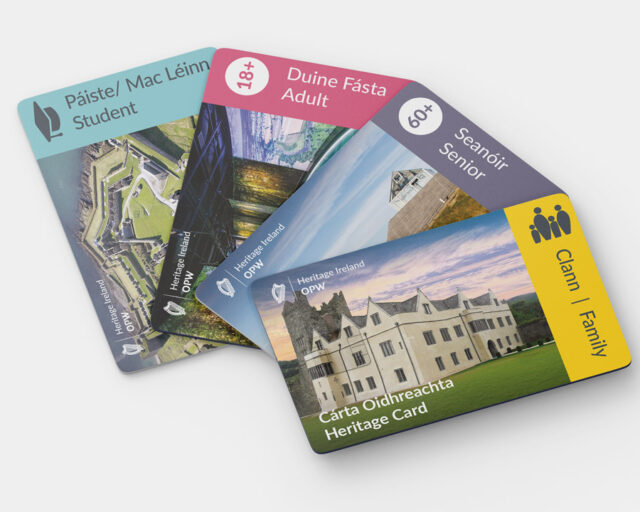Notice
Dunmore Castle is a National Monument in state guardianship
*For External Viewing Only, Internal Access is Not Permitted*
WARNING: It should be noted that these sites are unguided and a level of care and caution should be maintained during all stages of your visit. The Office Of Public Works (OPW) will not be held responsible for any damages, injuries, or losses that occur
Dunmore Castle
Dunmore Castle (Caisleán an Dúin Mhóir) sits on a small hillock 1km north of the historic town of Dunmore. The site is best described as multi-period castle, as various iterations have been built from c.1225 up to the 19th century when it fell into ruin. Today, people can see the shell of a rectangular keep measuring 14m x 8.2m, five storeys high and a large base-batter. The latter formed part of the castle defence, as well as the entry, because the east wall at first floor level was the front door. This was accessible from the ground using an external stairs, with two beam holes visible to support the framework.
Some of the architectural features that survive today are two mullioned windows with hood mouldings in the south wall, five fireplaces and an oculus window on north wall.
It is thought the original castle was built circa 1225 by the de Birmingham family who held the lordship of the manor of Birmingham in England for four hundred years. During Henry II’s 1172 Irish invasion, known as the Norman Invasion of Ireland, Sir William de Birmingham and his son Robert are listed as being among the Normans who assisted Strongbow on behalf of Henry II. As a result the family were later styled lords of the manor of the Barony of Athenry. The 1st Baron Athenry was Robert, with the Baron Athenry being one of the oldest titles in the Peerage of Ireland. Thomas Bermingham, the last Baron Athenry died January 11th 1799, and the title died with him.
Multiple attacks on the castle led to numerous iterations of Dunmore being built and rebuilt. In 1249 the castle was attacked and burned by the O’Connor’s. In 1284 it was besieged by the Ó Floinn family. In 1315 it was damaged during the Bruce campaign. A relativity quite period in the 16th century allowed for the rebuilding of the castle when an extra floor was added. Sir Henry Sidney, Lord Deputy of Ireland, took the castle from the de Birmingham family as they had rebelled against Queen Elizabeth I in 1569, but was returned later. The Cromwellian conquest of Ireland (1649-1653) finally saw the de Birmingham family lose control of the castle. It is at this time the Ouseley family enter the history of Dunmore Castle. The Ouseley’s were prominent landlords and preachers through the 18th and 19th centuries in this area of Galway. The famous Methodist preacher Gideon Ouseley was born at Dunmore in 1762. Gideon is known as Methodism’s ‘Apostle to the Irish’ because of his knowledge of the Irish language, and determination to convert and reform others, preaching up to 20 sermons a week, while riding a white horse! The mid-19th century saw the demise of Dunmore Castle, until it was taken into state ownership.
Protect our Past - Click here to read about the importance of protecting our country’s unique heritage sites
This national monument is protected in accordance with the National Monuments Acts 1930 to 2014
Gallery
Nearby sites to visit
Athenry Castle
An emblem of Norman lordship
Approx. 36.0 km from Dunmore Castle
Roscommon Castle-South West Tower
A dramatic and imposing thirteenth Century Norman Castle
Approx. 37.0 km from Dunmore Castle
Rathcroghan Visitor Centre
Follow in the footsteps of Queen Medb at Connacht’s ancient capital
Approx. 37.3 km from Dunmore Castle




